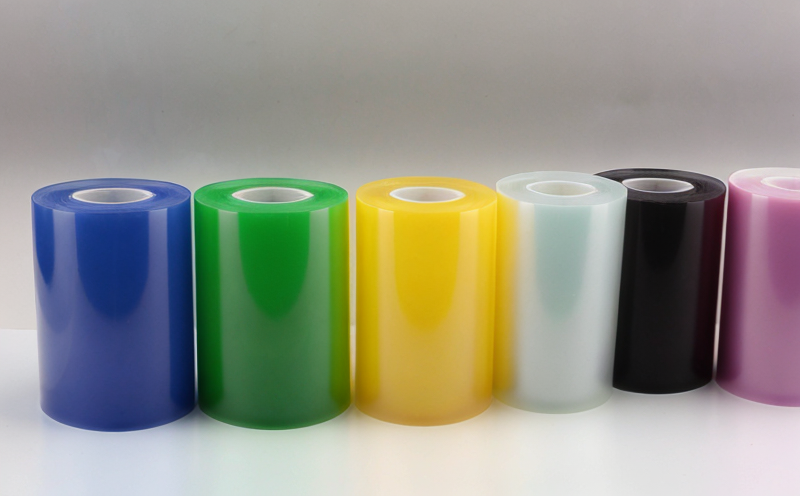ISO 1133 Melt Flow Rate Testing of Plastic Films
The ISO 1133 standard is a widely recognized method used to measure the melt flow rate (MFR) or melt mass flow rate (MMFR) of thermoplastic materials. This test quantifies how easily a polymer flows under specific temperature and load conditions, which is crucial for quality control, process optimization, and material selection in manufacturing processes.
For plastic films and sheets, understanding the MFR provides valuable insights into the processing behavior of the material during extrusion or blow molding operations. The test helps ensure that materials meet specified performance criteria, such as flowability, viscosity, and melt strength, which are critical for producing high-quality products.
The ISO 1133 test is performed using a twin-screw extruder or injection molding machine with an attached MFR tester. A standard sample of the plastic film or sheet is placed in the die, and the temperature and load conditions are set according to the specified parameters. The mass flow rate is then measured as the polymer melts and flows through the die.
Understanding the melt flow rate is essential for several reasons:
- Process Control: MFR helps in optimizing processing conditions, ensuring consistent product quality.
- Material Selection: It aids in selecting appropriate materials for specific applications based on their processing behavior.
- Quality Assurance: The test provides a reliable method to assess the consistency of material properties across batches or suppliers.
- Sustainability: By optimizing MFR, manufacturers can reduce energy consumption and improve recycling rates.
The accuracy and precision of ISO 1133 testing are paramount for maintaining product quality. Proper specimen preparation is critical, as even minor deviations in sample thickness or temperature can lead to erroneous results. Specimens should be cut from the film or sheet using a precise guillotine cutter and then conditioned according to the standard's requirements.
The test apparatus used must meet strict calibration standards to ensure accurate measurements. The extruder or injection molding machine, along with the MFR tester, must be regularly maintained and calibrated to ensure reliable performance. This ensures that the results are consistent and can be relied upon for decision-making purposes.
Understanding the implications of MFR testing in plastic films is essential for various stakeholders:
- Quality Managers: They use MFR data to monitor process stability and ensure product consistency.
- Compliance Officers: They rely on accurate MFR measurements to meet regulatory requirements and industry standards.
- R&D Engineers: They utilize MFR testing to develop new materials and optimize existing processes.
- Procurement Personnel: They use the results of MFR tests to evaluate suppliers and ensure they meet specified quality criteria.
In conclusion, ISO 1133 melt flow rate testing is a vital tool in the polymer & plastics industry, providing critical insights into material behavior during processing. By ensuring accurate and consistent measurements, manufacturers can optimize their processes, select appropriate materials, and maintain high-quality standards.
Why Choose This Test
Selecting ISO 1133 melt flow rate testing for plastic films offers several advantages:
- Consistency and Reliability: The test provides consistent results, allowing manufacturers to maintain high-quality standards.
- Simplified Process Monitoring: By measuring MFR, quality managers can easily monitor process stability and identify any deviations promptly.
- Informed Decision-Making: Accurate MFR data supports informed decisions regarding material selection and process optimization.
- Compliance Assurance: The test ensures compliance with international standards, enhancing the credibility of your products.
The ISO 1133 test is a cornerstone in the polymer & plastics industry. Its reliability and precision make it an indispensable tool for quality assurance, process optimization, and material selection.
International Acceptance and Recognition
The ISO 1133 standard enjoys widespread acceptance across various regions and industries. This international recognition ensures that the test results are universally accepted and comparable:
- North America: The United States, Canada, and Mexico recognize ISO standards as authoritative.
- Europe: Countries within the European Union use ISO 1133 to ensure quality and consistency in polymer manufacturing processes.
- Oceania: Australia and New Zealand also rely on this standard for their polymer testing needs.
- Asia-Pacific: China, Japan, South Korea, and other Asian countries have adopted ISO 1133 as a benchmark for melt flow rate testing.
The consistent use of the same standard across different regions ensures that results are comparable, facilitating global trade and collaboration.
Environmental and Sustainability Contributions
The ISO 1133 test contributes significantly to environmental sustainability by enabling manufacturers to optimize their processes:
- Energy Efficiency: By understanding the MFR, manufacturers can adjust processing conditions to minimize energy consumption.
- Recycling Rates: Accurate MFR data helps in selecting materials that are easier to recycle, reducing waste and landfill contributions.
- Material Selection: The test aids in choosing polymers with optimal flow properties, which can lead to more efficient production processes.
- Eco-friendly Production: By optimizing MFR, manufacturers can reduce the environmental footprint of their operations.
In conclusion, ISO 1133 melt flow rate testing is not only a technical requirement but also a step towards sustainable manufacturing practices. Its international acceptance ensures that quality and consistency are maintained across different regions, fostering global collaboration and innovation in the polymer & plastics industry.





